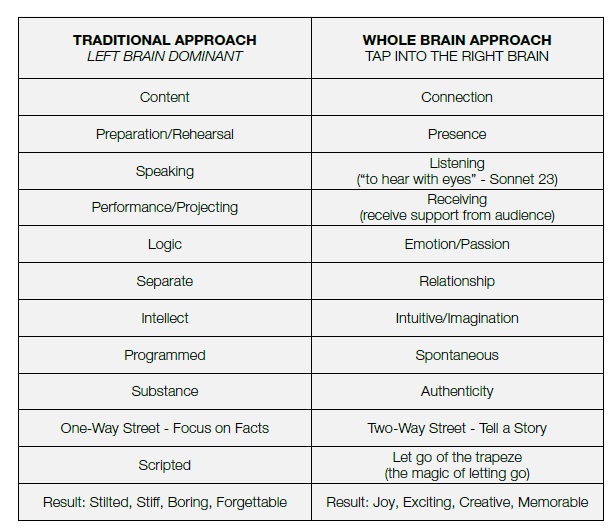Matthew Cossolotto offers more expert advice on how to improve your public speaking.
If you want to become a more comfortable, compelling and charismatic speaker, you should learn about the secrets of what I call ‘Whole Brain Speaking’. This involves balancing elements of both the Left Brain and the Right Brain in every presentation. Striking the right balance is key to speaking success.
The most successful speakers master a well-balanced combination of being present in the moment, on the one hand, with high-level preparation and performance skills on the other. Put simply, successful speakers find ways to pack authentic presence into every presentation.
Every speech or presentation is a real time relationship between speaker and audience. This is true whether you’re speaking on stage in a crowded ballroom or online in a Zoom-assisted webinar. As a speaker, you show that you value the relationship by being prepared, but not overly programmed.
Yes, it’s essential to prepare, to organize your material effectively and to rehearse. It’s not a good idea to simply go out on stage and 4wing it4 every time. You don’t want to just say the first thing that pops into your head. That’s not what being present in the moment means. That’s not what authentic speaking and connecting with the audience are all about.
Combine left and right Brain attributes
As you’ll see in the chart below, preparation, performance, and rehearsal are classic Left Brain functions. Presence, connection and authenticity reside on the right side of the brain.
In this chart, the column on the left summarizes the traditional Left Brain approach to public speaking. These qualities are important to any successful presentation, but total reliance on them will produce an unsatisfactory experience for both the speaker and the audience. Depending too much on these Left Brain qualities turns speeches and presentations into nothing more than boring, stale, uninspiring data dumps.
 My revolutionary Whole Brain Speaking approach is more holistic, interactive and relational. The idea is to take the Left Brain qualities as the bare essentials and then go the extra mile by tapping into the Right Brain. Whole Brain Speaking is the Value Added approach to speaking. The qualities in the left column get you part of the way there. To really wow your audiences, however, you need to add the Right Brain attributes. The goal is to transform a merely competent, informative speech into something truly moving and memorable.
My revolutionary Whole Brain Speaking approach is more holistic, interactive and relational. The idea is to take the Left Brain qualities as the bare essentials and then go the extra mile by tapping into the Right Brain. Whole Brain Speaking is the Value Added approach to speaking. The qualities in the left column get you part of the way there. To really wow your audiences, however, you need to add the Right Brain attributes. The goal is to transform a merely competent, informative speech into something truly moving and memorable.
The best way to use this chart is to pick any quality on the left side of the page and then consider ways to also incorporate the corresponding right brain quality on the right side. For example, once you’ve developed, rehearsed and mastered the content of your speech, give some attention to connecting with the audience.
Similarly, now that you’ve prepared your remarks, remind yourself to be present in the moment. While speaking to the audience, remember to also listen – with your ears and your eyes. Practice the art of hearing with your eyes, as Shakespeare refers to it in Sonnet 23. Don’t just project outward. Remember to receive the audience (especially the support from the audience). Don’t rely on logic and facts alone. Include an appeal to passion, emotion and imagination.
Let go of the trapeze
If you watch trapeze artists at the circus, the real excitement begins when they let go of the trapeze bar. There isn’t much interest in watching someone swing back and forth hanging from a trapeze bar. The magic happens between the bars. For speakers, being too scripted and programmed, anchoring your talk in Left Brain attributes, is essentially the same as clinging to the trapeze bar and just swinging back and forth.
You – and your audiences – deserve more than that. That way boredom lies.
Don’t be overly programmed. Demonstrate some degree of spontaneity. Tell a personal story. Bring along your personality and let it shine. Make sure the real you shows up. Let go of the trapeze once in awhile. Mix healthy doses of authenticity
with your great, finely honed substance. Turn your talk into a two-way relationship instead of simply a one-way information transfer.
In short, study the right-hand column carefully and incorporate many of these elements into your next speech or presentation. If you routinely feature this Value Added approach in your presentations, you will find yourself enjoying the experience much more—and so will your audience.
Remember this: audience members bring their whole brains – both the Left and the Right Brain – when they attend your presentations. And their Right Brains crave some attention. As a speaker, you should give it to them by using your whole brain. Let go of the trapeze. Pack presence into your presentation.
The result of a Left Brain only approach is predictable: A stilted, stiff, boring, forgettable presentation. If you tap into the Right Brain, your presentations will be more joyful, exciting, creative and memorable.
The choice is yours.
About the author
Matthew Cossolotto is a former NATO speech-writer. Author of The Joy of Public Speaking, Matthew conducts public speaking workshops and other Personal Empowerment Programs (PEPTalks) in Brussels and beyond. www.ThePodiumPro.com, Matthew.Cossolotto@gmail.com







